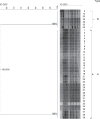First reported nosocomial outbreak of Serratia marcescens harboring bla IMP-4 and bla VIM-2 in a neonatal intensive care unit in Cairo, Egypt
- PMID: 30519059
- PMCID: PMC6233950
- DOI: 10.2147/IDR.S174869
First reported nosocomial outbreak of Serratia marcescens harboring bla IMP-4 and bla VIM-2 in a neonatal intensive care unit in Cairo, Egypt
Abstract
Introduction: Serratia marcescens is a significant hospital-acquired pathogen, and many outbreaks of S. marcescens infection have been reported in neonates. We report a sudden breakout of S. marcescens harboring the bla IMP-4 and bla VIM-2 metallo-β-lactamase (MBL) genes that occurred from March to August 2015 in the neonatal intensive care unit of Cairo University Hospital, Cairo, Egypt.
Methods: During the study period, 40 nonduplicate clinical isolates of S. marcescens were collected from blood culture samples. Matrix-assisted laser desorption/ionization time-of-flight mass spectrometry was used to identify each isolate. Then, minimum inhibitory concentrations of different antibiotics were assessed by the Vitek 2 compact system. Screening of the MBL genes bla IMP, bla VIM, bla SIM-1, bla SPM-1, and bla GIM-1 as well as the carbapenemase genes KPC, NDM, OXA-48, SME-1, and SME-2 were evaluated. Pulsed field gel electrophoresis was preformed to detect the genetic relationship of the isolates.
Results: Analysis showed that 37.5% of the S. marcescens clinical isolates were resistant to meropenem (minimum inhibitory concentrations ≥ 2 µg/mL), and bla IMP-4 and bla VIM-2 were the most prevalent MBL genes (42.5% and 37.5%, respectively). None of the other investigated genes were observed. Pulsed field gel electrophoresis typing revealed two discrete clones; 33/40 (82.5%) were pulsotype A and 7/40 (17.5%) were pulsotype B.
Conclusion: Here, we report for the first time the detection of MBL-producing S. marcescens isolates, particularly IMP-4 and VIM-2 recovered from inpatients with bacteremias from the intensive care unit at Cairo University Hospital.
Keywords: MALDI-TOFF; MBL genes; PFGE; SME-1; SME-2; carbapenemases; outbreak.
Conflict of interest statement
Disclosure The authors report no conflicts of interest in this work.
Figures
Similar articles
-
Phenotypic and genotypic investigation of metallo-β-lactamases in Pseudomonas aeruginosa clinical isolates in Bushehr, Iran.Iran J Basic Med Sci. 2022 Oct;25(10):1196-1200. doi: 10.22038/IJBMS.2022.64359.14154. Iran J Basic Med Sci. 2022. PMID: 36311200 Free PMC article.
-
[Examination of metallo-beta-lactamase-producing different types of Serratia marcescens detected in the same patient].Kansenshogaku Zasshi. 2013 Mar;87(2):189-94. doi: 10.11150/kansenshogakuzasshi.87.189. Kansenshogaku Zasshi. 2013. PMID: 23713329 Japanese.
-
Genetic Diversity of Carbapenem-Resistant Enterobacteriaceae (CRE) Clinical Isolates From a Tertiary Hospital in Eastern China.Front Microbiol. 2019 Jan 15;9:3341. doi: 10.3389/fmicb.2018.03341. eCollection 2018. Front Microbiol. 2019. PMID: 30697205 Free PMC article.
-
Emergence of NDM-1- and IMP-14a-producing Enterobacteriaceae in Thailand.J Antimicrob Chemother. 2012 Nov;67(11):2626-30. doi: 10.1093/jac/dks267. Epub 2012 Jul 13. J Antimicrob Chemother. 2012. PMID: 22796889
-
ML302, a Novel Beta-lactamase (BLA) Inhibitor.2012 Apr 16 [updated 2014 May 13]. In: Probe Reports from the NIH Molecular Libraries Program [Internet]. Bethesda (MD): National Center for Biotechnology Information (US); 2010–. 2012 Apr 16 [updated 2014 May 13]. In: Probe Reports from the NIH Molecular Libraries Program [Internet]. Bethesda (MD): National Center for Biotechnology Information (US); 2010–. PMID: 23762954 Free Books & Documents. Review.
Cited by
-
Protein determinants of dissemination and host specificity of metallo-β-lactamases.Nat Commun. 2019 Aug 9;10(1):3617. doi: 10.1038/s41467-019-11615-w. Nat Commun. 2019. PMID: 31399590 Free PMC article.
-
First Italian outbreak of VIM-producing Serratia marcescens in an adult polyvalent intensive care unit, August-October 2018: A case report and literature review.World J Clin Cases. 2019 Nov 6;7(21):3535-3548. doi: 10.12998/wjcc.v7.i21.3535. World J Clin Cases. 2019. PMID: 31750335 Free PMC article.
-
Characterization of a rare bla VIM-4 metallo-β-lactamase-producing Serratia marcescens clinical isolate in Hungary.Heliyon. 2020 Jun 27;6(6):e04231. doi: 10.1016/j.heliyon.2020.e04231. eCollection 2020 Jun. Heliyon. 2020. PMID: 32637682 Free PMC article.
-
First Report of bla IMP-4 and bla SRT-2 Coproducing Serratia marcescens Clinical Isolate in China.Front Microbiol. 2021 Oct 1;12:743312. doi: 10.3389/fmicb.2021.743312. eCollection 2021. Front Microbiol. 2021. PMID: 34659175 Free PMC article.
-
Smokeless Tobacco Harbors Bacteria Involved in Biofilm Formation as Well as Salt and Heavy Metal Tolerance Activity.Appl Biochem Biotechnol. 2024 Jun;196(6):3034-3055. doi: 10.1007/s12010-023-04689-2. Epub 2023 Aug 23. Appl Biochem Biotechnol. 2024. PMID: 37610514
References
-
- Mataseje LF, Boyd DA, Delport J, et al. Serratia marcescens harbouring SME-type class A carbapenemases in Canada and the presence of blaSME on a novel genomic island, SmarGI1-1. J Antimicrob Che-mother. 2014;69(7):1825–1829. - PubMed
-
- Wassef M, Abdelhaleim M, Ghaith D, El-Mahdy Y. Emerging New Delhi metallo-β-lactamase-1-type-producing Gram-negative bacteria isolated from Cairo University Pediatric Hospital, Cairo, Egypt. J Glob Antimicrob Resist. 2016;7:84–87. - PubMed
LinkOut - more resources
Full Text Sources
Miscellaneous


